Introduction of Indonesian Sulawesi-Toraja Wet Planer Coffee
For professional baristas, please follow the coffee workshop (Wechat official account cafe_style)
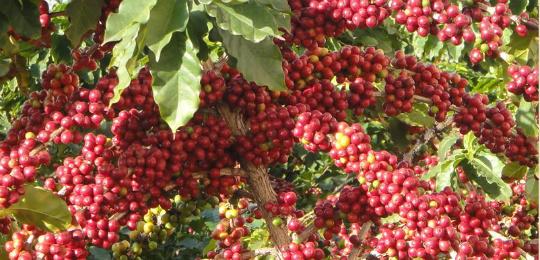
Indonesia Sulawesi-Toraja Bina lestari Coffee
Indonesia is the largest archipelago country in the world. Arabica tree species coffee was introduced and planted as early as the Dutch rule in the 18th century. The main producing areas are Sumatra, Java and Sulawesi. The deep, low-acidity and rich taste of Mantenin is called "the most important coffee in the world". It is also the fourth largest producer in the world with an annual output of 7 million bags. Coffee is harvested twice a year in May-June and September-October respectively. Sumatra and Aceh have the largest production. The scale of the coffee farm is not about 1 ~ 3 hectares. Mantenin coffee treatment in Indonesia generally adopts semi-washing method. Coffee farmers harvest ripe coffee beans, remove the external peel and pulp but retain the thin film tissue on the coffee beans. After the process of immersion and fermentation, the unsound beans floating on the water surface are removed, while the strong and sunken beans with the surface film can be sunlit or directly to the ground. Finally, a dryer is used to make the moisture content reach a unified standard. The most unique thing is to use parchment to cover coffee beans with film to maintain a moisture content of 18%. Before shipment, the coffee bean surface film is polished and cleaned. The world calls this section of the special treatment method called Indonesian-style semi-washing method, large coffee processing plants can accurately control each treatment process, flavor and taste has a certain level. On the other hand, small coffee farmers treat raw beans in their own yard, and the flavor will vary according to the handling methods and skills of different coffee farmers.
The coffee produced in Sulawesi, Indonesia's third largest island, accounts for only 9% of Indonesia's coffee production every year. Coffee grows in the rainforest at 750-1500 meters above sea level. Most of the high-quality coffee is grown around the Toraja platform in the southwest. Tonaga is located at an altitude of 1500 meters above sea level on the equatorial belt shrouded with rain and clouds in the afternoon, coupled with the fertile volcanic soil, which are the best natural climate and environment for coffee growth. Most Indonesian coffee is sold, sold and exported by local coffee companies. Direct Coffee is introduced to small-scale Binalestari coffee merchants in Sulawesi Tonaga. Coffee is several grades G1 in Arabica. The raw coffee beans show a long rice-shaped color of emerald green, which is different from the yellowish brown of gold Mantenin and Sumatra Manning (compared with photos on the blog), and there are fewer defective beans and unfermented white beans. It's a good coffee from a small manor that doesn't have a disturbing earthy smell.
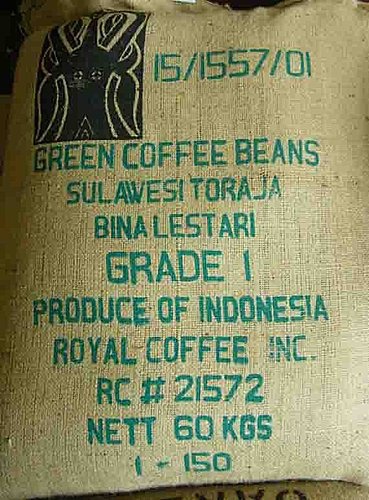
Sulawesi Tonaga (Toraja) has the label "Bina lestari" on the coffee bean bag.
Coffee tree species is Arabica, and the best grade is G1 first-grade beans (G2.G3 in sequence)
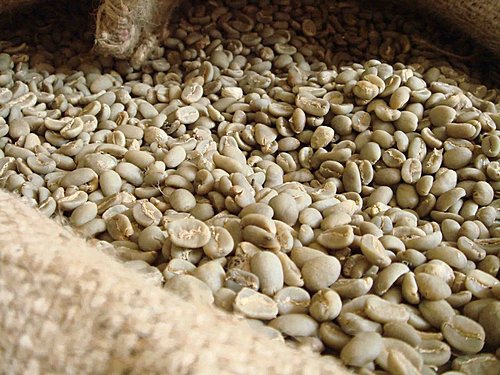
Coffee has the perfect long rice type.
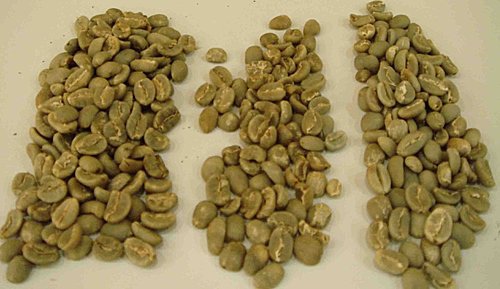
The above picture is in order from left to right
Gold Mantenin Siti Karan (Sidikalang) Mountain Mantenin Indonesia Sulawesi-Tonaga
Huang Man and Siti Karan Mountain Mantenin are similar in color to yellowish brown, while Indonesia's Sulawesi Tonaga is green.
There is little difference between Huang Man and Sulawesi Tona in Indonesia.
The end of shallow baking (City): after grinding the beans, there is a clear taste of fairy grass, the special aroma of ginseng and licorice is not disturbing earthy and fishy smell, the taste is clean, light and complex, not bright citrus acid and sweet honey, and the finish has the aroma and tea feeling of alpine oolong tea.
Re-baking second explosion (Full City): the coffee has the aroma of creamy popcorn after grinding, the sweetness of dark chocolate after brewing, the complex aroma and smooth ester taste, and the sweetness of longan honey and brown sugar in the finish.
If the Sulawesi Tonaga coffee is roasted to a slightly strong to strong flavor, it has a rich maltose taste and a low herbal flavor of Indonesian mantenin, which is very different from light roasting and is a great choice on a par with golden manning.
Cup test date: 2010.08.25
Dry aroma: 9
Wet aroma: 8
Clean: 9
Brightness: 8
Palate: 9
Balance: 7
Complexity: 7
Sweetness: 8
Acid quality: 8
Yu Yun: 9
Overall comment: Sulawesi Tonaga also maintains the ancient traditional mode of production in Indonesia. Small-area coffee farms also have washed, dried and semi-washed coffee beans, which is the most special area of all Indonesian coffee beans. although his concentration is not as thick as Sumatra Mantenin, it has a little more smoothness and less earthy and mushroom flavor. The acidity also improves and leaves a refreshing fruity flavor.
Important Notice :
前街咖啡 FrontStreet Coffee has moved to new addredd:
FrontStreet Coffee Address: 315,Donghua East Road,GuangZhou
Tel:020 38364473
- Prev
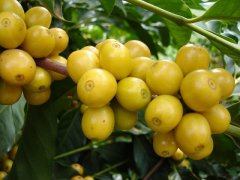
An introduction to the difference between sun-cured coffee beans and wind-stained Malaba in Alecon Farm, India
For the exchange of professional baristas, please follow the coffee workshop (Wechat official account cafe_style) Budan producing area in India-Alakon Farm (Yelnoorkhan Estate) Sun Bean Coffee was brought into the establishment of the first coffee farm by pilgrims as early as the 16th century. You may not imagine that India produces a lot more coffee than Ethiopia and any Central American country, with 900000 hectares.
- Next
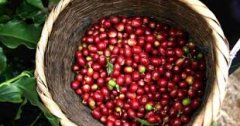
Comparison of Mantenin and Golden Mantenin data in the West Tikalan Mountains in the Lake area of Indonesia
For the exchange of professional baristas, please follow the coffee workshop (Wechat official account cafe_style) Indonesia Sumatra-Toba Lake District (Lake Toba) West Tikran Mountains (Sidikalang) Mantenin Indonesia is the world's largest archipelago country, as early as the 18th century Dutch rule introduced Arabica tree coffee cultivation, the main producing areas are located in Sumatra, Java and Sulawesi Island, so
Related
- Detailed explanation of Jadeite planting Land in Panamanian Jadeite Manor introduction to the grading system of Jadeite competitive bidding, Red bid, Green bid and Rose Summer
- Story of Coffee planting in Brenka region of Costa Rica Stonehenge Manor anaerobic heavy honey treatment of flavor mouth
- What's on the barrel of Blue Mountain Coffee beans?
- Can American coffee also pull flowers? How to use hot American style to pull out a good-looking pattern?
- Can you make a cold extract with coffee beans? What is the right proportion for cold-extracted coffee formula?
- Indonesian PWN Gold Mandrine Coffee Origin Features Flavor How to Chong? Mandolin coffee is American.
- A brief introduction to the flavor characteristics of Brazilian yellow bourbon coffee beans
- What is the effect of different water quality on the flavor of cold-extracted coffee? What kind of water is best for brewing coffee?
- Why do you think of Rose Summer whenever you mention Panamanian coffee?
- Introduction to the characteristics of authentic blue mountain coffee bean producing areas? What is the CIB Coffee Authority in Jamaica?

